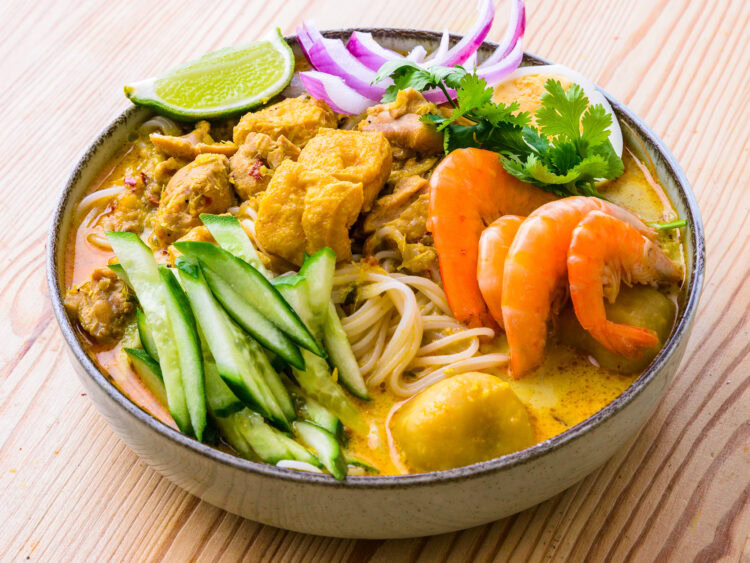A spicy coconut broth loaded with shrimp, chicken, rice noodles, and fresh herbs—rich, aromatic laksa.
The first thing you notice is the aroma. Coconut cream blooms in a peppery heat that swirls above the pots of a Kuala Lumpur food court.
One spoonful later, the dish’s quiet thesis reveals itself : the laksa lemak is “one bowl, many cultures,” a soup that distills centuries of migration, marriage, and maritime exchange into a velvety broth.
To fully appreciate it, we return to the straits where it was born. We watch the spice paste that gives it body, weigh purists’ principles against modern liberties, then dig in while the noodles are still squeaking between chopsticks.
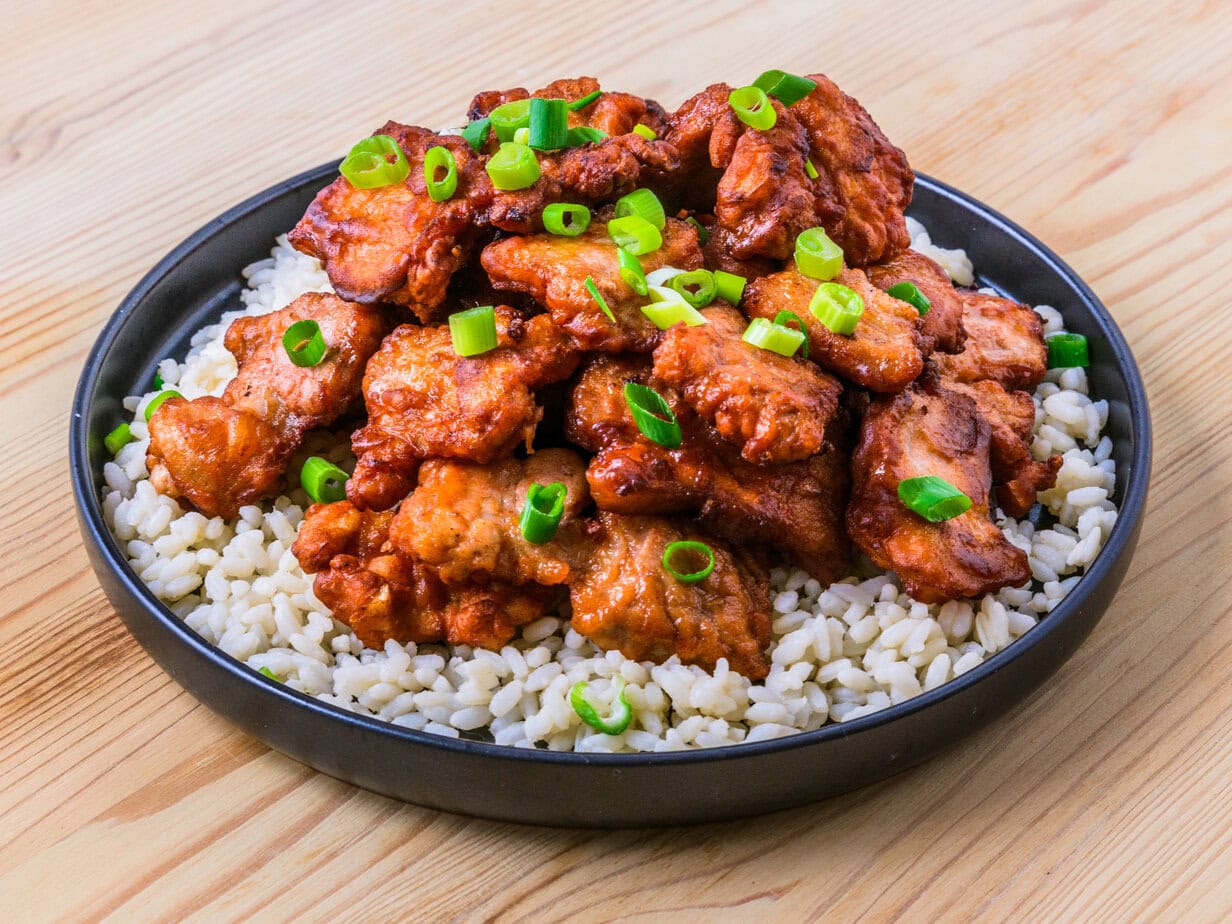
Origins & Culture
The story of laksa begins with the Peranakans, descendants of Chinese traders who settled on the Malay Peninsula centuries ago and married local women. In their kitchens, Chinese noodle soups mingled with Malay spice pastes, giving birth to a boldly aromatic new canon.
Port cities such as Malacca and Penang continued to enrich the bowl : according to some oral traditions, the ancient sea routes also brought spices such as cinnamon and cloves.
Meanwhile, dried shrimp arrived by the sackful from the coasts of Borneo. Over time, the soup settled under a single name—sometimes called laksa lemak, sometimes curry laksa depending on the region—but its soul remained unmistakable.
Today, it’s a weekday breakfast, monsoon comfort, and the street-stall litmus test ; if the line isn’t long, regulars keep walking.
Anatomy of the Bowl
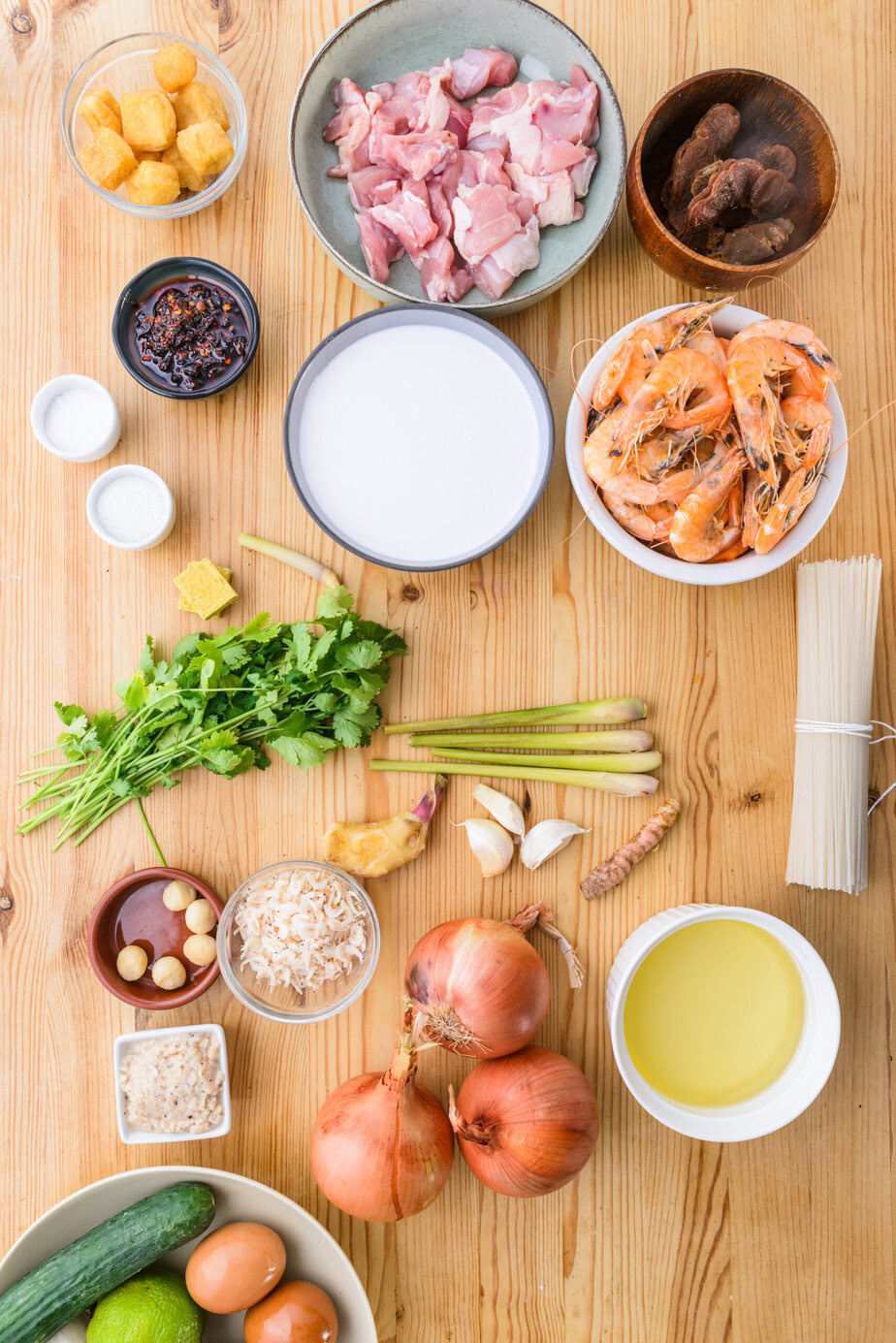
The rempah is the heart of the dish : a brick-red spice paste that crackles on contact with hot oil. Onions (or large “banana” shallots) and garlic bring sweetness, while thumb-sized chunks of fresh turmeric and galangal lend gingery warmth.
Four bruised stalks of lemongrass offer a citrusy lift ; belacan (fermented shrimp) adds earthy depth ; five candlenuts (or, failing that, macadamias) melt into the mixture to make it even silkier. Fry the paste until the oil turns orange and perfumes the whole kitchen.
The broth gains character thanks to a double stock : shrimp shells simmered in their own stock, which we then reinforce with a few chicken bouillon cubes and chicken pieces until the liquid takes on a sunset hue.
Thick coconut milk, added at the end of cooking, wraps everything in a silky veil while still letting the chili heat shine through.
The noodles are fresh rice ribbons made for laksa, sturdy enough to hold the sauce yet elastic enough to escape the spoon. Japanese wheat ramen or mung bean glass noodles will float just as merrily, but the chew differs ; for many Malaysians, that’s exactly the point.
The toppings evoke a wet market stall. Poached shrimp nestle on the surface ; bite-size pieces of chicken sink halfway ; meanwhile, tofu puffs soak up the broth, releasing a coconut note with every bite. Fish balls or paper-thin slices of surimi are optional flourishes that nod to the dish’s coastal heritage.
The finishing touch is bright and raw : shredded Vietnamese coriander (daun kesum) and a few shards of torch ginger buds breathe minty freshness, lime wedges add tang, and a spoonful of shrimp sambal rests on the rim for those who measure pleasure in Scoville units.
What makes a true laksa?
Purists draw three lines in the sand : belacan for depth, kesum for herbal fragrance, and coconut milk for body. Replacing any of these pillars with a gentler substitute will indeed yield a tasty soup ; it just won’t be laksa lemak.
Street stalls, however, are pragmatic. Some stretch the coconut milk with powdered milk to cut costs ; hurried cooks lean on ready-made pastes ; vegans experiment with fermented soy in miso to mimic the savory edge of shrimp paste.

Abroad, creativity flourishes. A Melbourne food truck swirls macadamia butter into the broth for extra sheen, while a New York ramen bar plunges curly wheat noodles into laksa so diners can twirl rather than slurp.
In the end, authenticity is judged where chopsticks meet the mouth : does the bowl evoke home, or at least a memory we want to cherish?
How to serve and enjoy laksa
The bowl is usually assembled in quick layers : the noodles go in first ; a scalding cascade of golden broth follows ; then shrimp, chicken, and tofu shimmer in the rising steam.
Halves of hard-boiled eggs and matchsticks of cucumber temper the heat, while a handful of extra blanched shrimp crowns festive versions.
A brisk squeeze of fresh calamansi cuts through the richness of the coconut milk with bright acidity, and a pale lager from neighboring Thailand hits the same balance. There’s rarely any broth left, but if there is, reducing it the next day on the stove yields an ocean-kissed coconut stew perfect for mussels or as a spicy base for risotto.
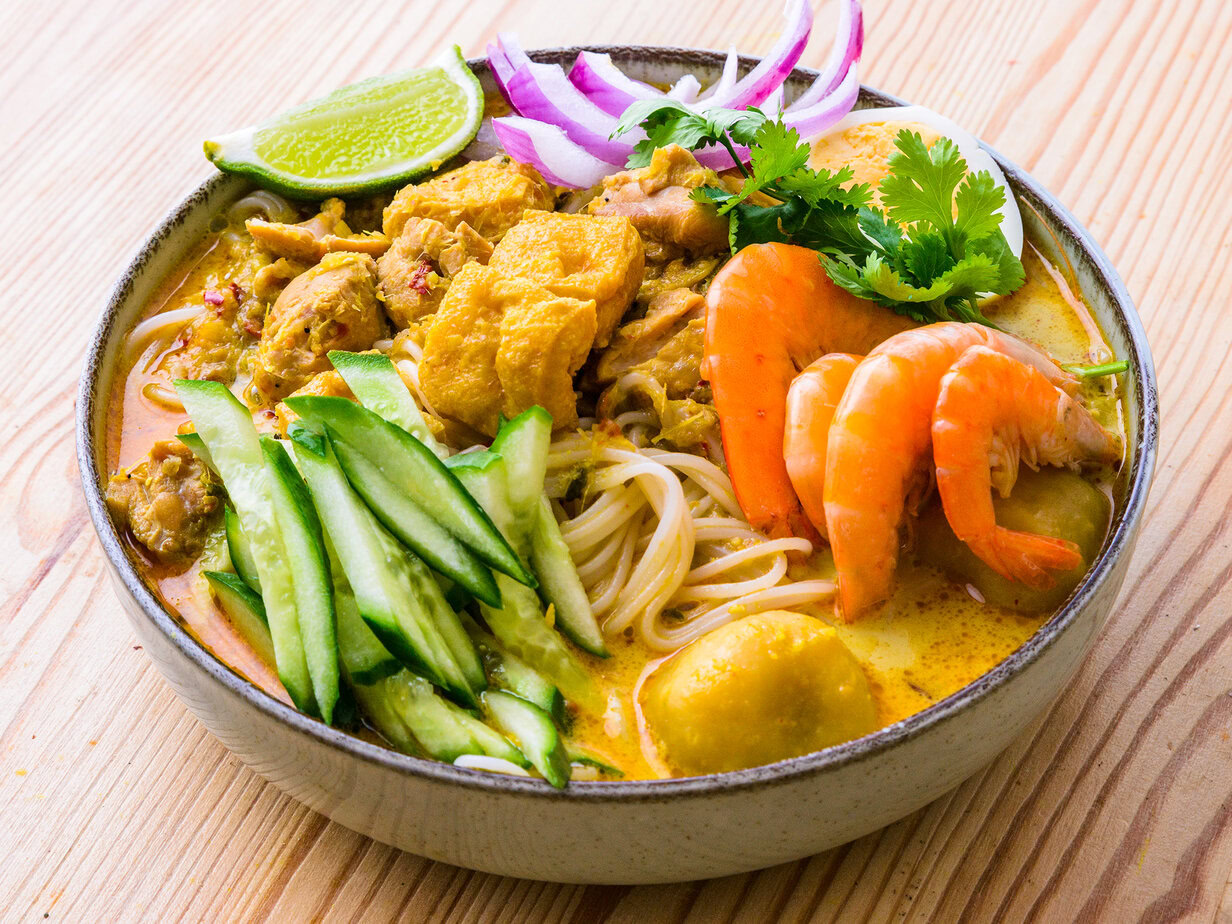
Ingredients
Spice Paste
- 3 medium onions
- 3 cloves garlic
- 1 handful dried shrimp rinsed and briefly soaked
- 4 stalks lemongrass
- 4 cm fresh turmeric root
- 1 teaspoon roasted shrimp paste belacan
- 3 cm galangal
- 5 candlenuts or substitute macadamia nuts
- 180 ml neutral oil for frying the paste
Ingredients
- 1 bunch Vietnamese coriander
- 2 flowers torch ginger optional; substitute the small tender inner core of a lemongrass stalk
- 4 tablespoons chili paste
- 2 cups thick coconut milk
- 2.5 L water
- 500 g medium shrimp cooked in 440 ml of water; keep the cooking liquid
- 500 g chicken cut into small pieces
- 10 balls tofu puffs halved
- 2 cubes chicken bouillon
- 5 slices dried tamarind
- salt to taste
- pinch of sugar to taste
- 1 package laksa rice noodles cooked until tender
Optional Ingredients and Garnishes
- fish balls as desired
- sliced fish cake as desired
- extra blanched shrimp as desired
- extra kesum leaves finely sliced
- 1 red onion finely sliced
- hard-boiled eggs halved
- 1 cucumber julienned
- shrimp sambal
- lime wedges
Instructions
Preparation
- Cook the shrimp in 500 ml of water and set aside.
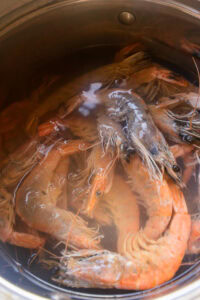
- Blend all the spice paste ingredients until smooth.3 medium onions, 3 cloves garlic, 1 handful dried shrimp, 4 stalks lemongrass, 4 cm fresh turmeric root, 1 teaspoon roasted shrimp paste, 3 cm galangal, 5 candlenuts
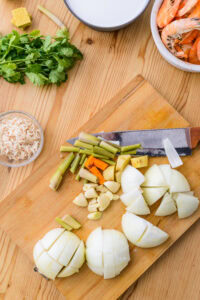
- Heat the neutral oil, then sauté the blended spice paste with the chili paste until the oil separates and the mixture is very fragrant.180 ml neutral oil, 4 tablespoons chili paste
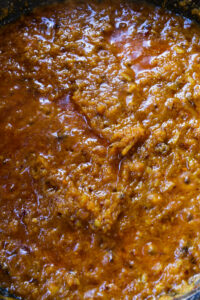
- Add the water and bring to a boil. Stir in the chicken and cook until done, then add the Vietnamese coriander, torch ginger, bouillon cubes, fish balls, sliced fish cake, tofu puffs, and the reserved shrimp stock.2.5 L water, 500 g chicken, 1 bunch Vietnamese coriander, 2 flowers torch ginger, 2 cubes chicken bouillon, fish balls, sliced fish cake, 10 balls tofu puffs, 500 g medium shrimp
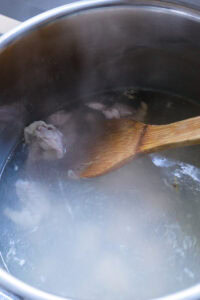
- Pour in the coconut milk, stirring constantly to prevent curdling. As soon as it returns to a boil, turn off the heat and season with salt and sugar.2 cups thick coconut milk, salt, pinch of sugar
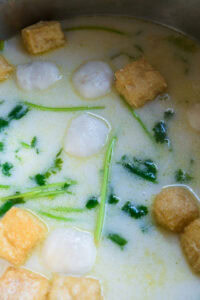
Serving
- Place the laksa rice noodles in a bowl. Generously ladle the coconut broth and toppings over the noodles, then garnish with sliced red onion, julienned cucumber, kesum leaves, a lime wedge, half a hard-boiled egg, and, if desired, blanched shrimp.1 package laksa rice noodles, 1 red onion, 1 cucumber, extra kesum leaves, lime wedges, hard-boiled eggs, extra blanched shrimp

- Serve the shrimp sambal on the side.shrimp sambal
Notes
This version is a laksa lemak/curry-laksa hybrid: coconut-rich, seafood-forward, and brightened with local herbs.
Culinary Sources
• Deconstructing Laksa, a Fusion Dish of Malaysia and Singapore – National Geographic (English)
• Malaysian Curry Laksa – Reddit (English)
• Authentic Sarawak Laksa Recipe – TasteAtlas (English)
• Homestyle Sarawak Laksa 砂拉越叻沙 – Huang Kitchen (English)
